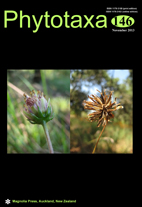Abstract
Recent botanical explorations in western Mexico, as part of a taxonomic revision and a phylogenetic analysis of the genus Cosmos, have resulted in the discovery of two new species. The novelties belong to Cosmos section Discopoda and are described and illustrated. Morphologically, Cosmos pseudoperfoliatus resembles C. jaliscensis, C. peucedanifolius, C. palmeri and C. scabiosoides, but differs from them in having 4–7 leaf pairs on the stem, leaves tomentose on both faces, trullate external phyllaries, yellow disk florets with 4–5 lobes, and corky-tuberculate achenes. On the other hand, Cosmos ramirezianus is morphologically similar to C. montanus, but differs by its coriaceous and pinnatisect leaves, yellow internal phyllaries, yellow disk florets with light purple lobes, and by the persistence of paleae during fruiting. Phenology, distribution and habitat are provided as well as a key for the identification of the species in Cosmos section Discopoda.
References
Berchtold, F.G. & Presl, J.S. (1820) O přirozenosti rostlin. Prague, Czechoslovakia, 324 pp.
Bentham, G. (1844) Coreocarpus. In: Hinds, R.B. (ed.) The Botany of the voyage of H.M.S. Sulphur, under the command of captain Sir Edward Belcher, R.N., C.B., F.R.G.S., etc. during the years 1836–42. Smith, Elder & Co., London, pp. 28.
Candolle, A.P. de (1836) Prodromus systematis naturalis regni vegetabilis 5. Treuttel & Würtz, Paris, 706 pp.
Cavanilles, J.S. (1791) Icones et descriptiones plantarum, quae aut sponte in Hispania crescunt 1. Lazaro Gayguer, Madrid, 67 pp.
Cavanilles, J.S. (1794) Icones et descriptiones plantarum, quae aut sponte in Hispania crescunt 3. Lazaro Gayguer, Madrid, 169 pp.
Crawford, D.J. & Stuessy, T.F. (1981) The taxonomic significance of anthochlors in the subtribe Coreopsidinae (Compositae, Heliantheae). American Journal of Botany 68: 107–117.
http://dx.doi.org/10.2307/2442998Crawford, D.J., Tadesse, M., Mort, M.E., Kimball, R.T. & Randle, C.P. (2009) Coreopsideae. In: Funk, V.A., Susanna, A., Stuessy, T.F. & Bayer, R.J. (eds.) Systematics, evolution and biogeography of Compositae. International Association for Plant Taxonomy, Vienna, pp. 713–730.
Gray, A. (1854) Plantae Novae Thurberianae: the characters of some new genera and species of plants in a collection made by George Thurber, Esq., of the late Mexican boundary commission, chiefly in New Mexico and Sonora. Memoirs of the American Academy of Arts and Sciences, New Series 5: 297–328.
http://dx.doi.org/10.2307/25058183Greenman, J.M. (1908) The generic name Goldmania. Botanical Gazette 45: 198.
Hernández-López, L. (1995) The endemic flora of Jalisco, Mexico, centers of endemism and implications for conservation. MS Thesis. University of Wisconsin, Madison, 76 pp.
Hooker, J.D. (1861) Cosmos diversifolius; var. atro-sanguineus. Curtis Botanical Magazine (3rd ser.) 87: ad tab. 5227.
IUCN (2008) IUCN red list categories and criteria, ver. 7. IUCN, Gland, Switzerland and Cambridge, U. K.
http://www.iucnredlist.org/Jeffrey, C. (1977) Corolla forms in Compositae – some evolutionary and taxonomic speculations. In: Heywood, V.H., Harborne, J.B. & Turner, B.L. (eds.) The biology and chemistry of the Compositae. Academic Press, London, pp. 111–118.
Kimball, R.T. & Crawford, D.J. (2004) Phylogeny of Coreopsideae (Asteraceae) using ITS sequences suggests lability in reproductive characters. Molecular Phylogenetics and Evolution 33:127–139.
http://dx.doi.org/10.1016/j.ympev.2004.04.022Kunth, C.S. (1820) Nova genera et species plantarum. N. Maze, Paris, 412 pp.
La Llave, P. de (1824) Hidalgoa. In: La Llave, P. de & Martínez de Lexarza, J. (eds.) Novorum vegetabilium descriptiones. Martinum Riveram, Mexico, pp. 15.
Lessing, C.F. (1831) De plantis in expeditione romanzoffiana observatis disserere pergitur. Synathereae addendae. Linnaea 6: 501–526.
Lindley, J. (1841) Natural Arrangement. Part II. In: Loudon, J.C. An encyclopedia of plants: comprising the specific character, description, culture, history, application in the arts, and every other desirable particular respecting all the plants indigenous, cultivated in, or introduced to Britain. London, 1334 pp.
Linnaeus, C. (1753) Species Plantarum. Salvius, Stockholm, 1200 pp.
McVaugh, R. (1984) Compositae. In: Anderson, W.R. (ed.) Flora Novo-Galiciana, a descriptive account of the vascular plants of Western Mexico 12. The University of Michigan Press, Michigan, 1157 pp.
Melchert, T.E. (1975) New combinations in the Coreopsidinae. Phytologia 32: 291–298.
Mort, E.M., Randle, C.P., Kimball, R.T., Tadesse M. & Crawford, D.J. (2008) Phylogeny of Coreopsideae (Asteraceae) inferred from nuclear and plastid DNA sequences. Taxon 57: 109–120.
Panero, J.L. & Funk, V.A. (2002) Toward a phylogenetic subfamilial classification for the Compositae (Asteraceae). Proceedings of the Biological Society of Washington 115: 909–922.
Richard, P.C. (1807) Chrysantellum. In: Persoon, C.H. (ed.) Synopsis plantarum 2. J.G. Cottam, Paris, pp. 471.
Robinson, B.L. (1909) Diagnoses and transfers of the Tropical American phanerogams. Proceedings of the American Academy of Arts and Sciences 44: 613–626.
Robinson, H. (1981) A revision of the tribal and subtribal limits of the Heliantheae (Asteraceae). Smithsonian Contributions to Botany 51: 1–102.
Rodríguez, A., Harker, M., Quezada-Solís, A. & Casillas-Gaeta, S. (2006) Diversidad y potencial ornamental del género Cosmos Cav. (Asteraceae) en Jalisco. In: Carvajal, S. (ed.). Avances en la investigación Científica en el CUCBA: XVII Semana de la Investigación Científica. Centro Universitario de Ciencias Biológicas y Agropecuarias, Universidad de Guadalajara. Jalisco, México. 610–619 pp.
Ryding, O. & Bremer, K. (1992) Phylogeny, distribution and classification of the Coreopsideae (Asteraceae). Systematic Botany 17: 649–659.
SEMARNAT (2013) Base de datos estadísticos. Abreviaturas y símbolos. Entidades federativas. Mode of access:
http://www.semarnat.gob.mx/informacionambiental/documents/sniarn/estadistica/abreviaturas.htmlSherff, E.E. (1932) Revision of the genus Cosmos. Field Museum of Natural History, Botanical Series 8: 401–447.
Sherff, E.E. (1955) Cosmos. In: Sherff, E.E. & Alexander, E.J. (eds.) North American Flora 2. The New York Botanical Garden, New York, pp. 149.
Sherff, E.E. (1964) Some new or otherwise noteworthy Coreopsidinae (Compositae) from Mexico. Brittonia 16: 58–73.
Turner, B.L. (1977) Henricksonia (Asteraceae: Coreopsidinae), a newly discovered genus with a palaceous pappus from North Central Mexico. American Journal of Botany 64: 78–80.
Vargas-Amado, G., Castro-Castro, A., Harker, M., Villaseñor, J.L., Ortiz, E. & Rodríguez, A. (2013) Distribución geográfica y riqueza del género Cosmos (Asteraceae, Coreopsideae). Revista Mexicana de Biodiversidad 84: 122–155.
Voss, A. (1894) Vilmorin’s Blumengärtnerei. Beschreibung, Kultur und Verwendung des gesamten Pflanzenmaterial für Deutsche Garten 1. Parey, Berlin, 450 pp.
Wedell, H.A. (1856) Chloris Andina 1(3). P. Bertrand, Paris, pp. 57–80.

